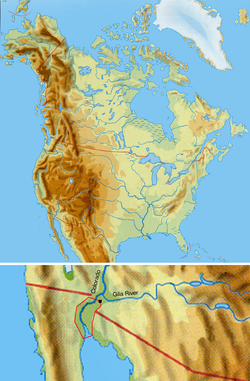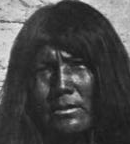Cocopah
 Middle Sky, Cocapah, photo byFrank A. Rinehart,1899 (hand-colored) | |
| Total population | |
|---|---|
| 1,009 in the United States (2010)[1] | |
| Regions with significant populations | |
( | |
| Languages | |
| Cocopah,English,Spanish | |
| Religion | |
| Traditional tribal religion | |
| Related ethnic groups | |
| otherYumanpeoples |
TheCocopah(Cocopah:Xawiƚƚ Kwñchawaay) areNative Americanswho live inBaja California,Mexico, andArizona,United States.
In the United States, Cocopah people belong to thefederally recognizedCocopah Tribe of Arizona.
Name
[edit]The Cocopah are also called theCucapá(inCocopa:KwapaorKwii Capáy.
Language
[edit]TheCocopah languagebelongs to the Delta–California branch of theYuman family.Their self-designation isXawiƚƚ kwñchawaay,translating to “Those Who Live on the Cloudy River” (fromXawíƚƚy- "river",kwii- "cloud",(ny)way- "to live",llyay/nyaam- "many" ). According to the US Census, there were 1,009 Cocopah in 2010.[1]
Alternate spellings of Cocopah in Spanish documents include: Cócopa, Cócapa, Cócope, Cósopa, Cúcapa.[2]
History
[edit]
Precontact
[edit]Ancestors of the Cocopah inhabited parts of present-dayArizona,California,andBaja Californiaand are known by western academics as belonging to thePatayan culture.Patayan is a term used by archaeologists to describe prehistoricNative Americancultures who inhabited parts of modern-dayArizona,west toLake CahuillainCalifornia,and inBaja California,between 700 and 1550 A.D. This included areas along theGila River,Colorado Riverand in theLower Colorado River Valley,the nearby uplands, and north to the vicinity of theGrand Canyon.They are mostly likely ancestors of the Cocopah and other Yuman-speaking tribes in the region. The Patayan peoples practicedfloodplain agriculturewhere possible and relied heavily onhunting and gathering.
Post-contact
[edit]The first significant contact of the Cocopah withEuropeans and Africansprobably occurred in 1540, when theSpanishexplorerHernando de Alarcónsailed into the Colorado River delta. The Cocopah were specifically mentioned by name by the expedition ofJuan de Oñatein 1605.
Post-Mexican cession
[edit]After theMexican-American War,Cocopah lands were split between the US and Mexico through theMexican Cessionresulting from theTreaty of Guadalupe Hidalgo.
Westward expansion in the 1840s and the discovery of gold in California in 1849 brought many migrants through the area near the mouth of the Colorado River and the Grand Canyon region. The strategic importance of the river crossing was recognized by the U.S. government, and the United States Army established Camp Independence in 1850 to protect the entry route through the tribe's territories. Many tribes along the Colorado River entered the ferry business given its profitability, creating many jobs for the Cocopah.[3]
The Cocopah agreed to join Garra's Tax Revolt of 1851, led by theCupeño,to fight against the US government alongside theQuechanand nearbyKumeyaaybands. Together, the Cocopah sieged Camp Independence but the siege fell apart after disputes with the Quechan over the distribution of sheep confiscated from white sheepherders earlier.
The Cocopah also entered theYuma Warfollowing the tax revolt initially on the side of the Quechan against the US. After making peace with the US, the Cocopah allied with thePaipaiand Halyikwamai and turned against the Quechan, after accumulating tension between the two tribes. War broke out in May 1853, when the Cocopah besieged three Quechan villages holding them hostage. In retaliation, the Quechan-allied Mohave backed the Quechan and raided the Cocopah. The Yuma War came to an end when the US threatened the Mojave that they would intervene on the side of the Cocopah.
Cocopah in the Mexican Revolution
[edit]During the Mexican Revolution, theMagonistasgained the support of the Cocopah, under the influence of Camilo Jiménez, who was the tribal leader of the Cocopah in the Mexicali Valley. The Cocopah were sympathetic of the Magonist struggle against imperialism from both Mexico and the US, and the privatized ownership of their land. The Cocopah were joined by the Paipai,Kiliwa,and Kumeyaay, and prepared to fight alongside the Magonistas, as Jiménez smuggled US arms to Mexico with the support of theIndustrial Workers of the World(IWW).[4]
On January 29, the Magonistas and the Cocopahcaptured Mexicaliand provided further logistical support throughout their lands. Jiménez carried out a campaign with the Cocopah, Paipai, and Kiliwa armies fromEl RosariotoEnsenada,raiding small towns and lootingChinese-Mexicanbusinesses.[4]
The Cocopah were eventually defeated by the Mexican forces in the following months and were forced off of their land by the Colorado River Land Company.[4]
Modern era
[edit]In 1964, the Cocopah Tribe of Arizona, on the US side of the border, ratified its first constitution and formed a five-person Tribal Council in theCocopah Indian Reservation.In the late 1970s and 1980s, the tribe acquired additional land, constructed homes, installed utilities, developed infrastructure, and initiated economic development.[3]
Cocopah Tribe of Arizona
[edit]Cocopah peoples in the United States are enrolled in theCocopah Tribe of Arizona.As of the 2000 United States Census, the Cocopah Tribe of Arizona numbered 891 people.[1]There is acasino, speedway, resort, family entertainment center and bingo hallon the reservation as well as a Museum and Cultural Center.[5]Another Yuman group, theQuechan,lives in the adjacentFort Yuma Indian Reservation.On important occasions, Cocopah people wear their customary ribbon shirts and ribbon dresses.
Settlements
[edit]Cocopah people live inMexicali Municipality,Baja California(settlements of Campo Camerina (Colonia Terrenos Indios), Campo del Prado (Colonia el Mayor), Campo Flores, Campo Sonora (Colonia Terrenos Indios), Colonia la Puerta, Comunidad Indígena Cucapá el Mayor [Ejido el Mayor], Ejido Cucapá Mestizo, Ejido Doctor Alberto Mota (El Indiviso), Ejido Durango, Ejido México, Familia Regalado (Ejido Sonora 2 Campos Nuevos), La Casa de las Curvas (Colonia el Mayor), Mexicali, Sainz Domínguez (Colonia el Mayor), and San Felipe) andSan Luis Río Colorado Municipality,Sonora(settlements of Pozas de Arvizu (La Reserva), and San Luis Río Colorado),Mexico,[6]and inSomerton,Arizonain theUnited States.
Notes
[edit]- ^abcU.S. Census Bureau, Census 2010 Census 2010 American Indian and Alaska Native Summary File (AIANSF) - Sample Data, Cocopah Tribe of Arizona alone or in Combination, M22
- ^Barnes, Thomas C.; Naylor, Thomas H.; Polzer, Charles W.Northern New Spain: A Research Guide.University of Arizona.RetrievedMay 10,2024.
- ^ab"About Us - Cocopah Indian Tribe".cocopah.RetrievedSeptember 6,2020.
- ^abcMuñoz, Gabriel Trujillo (2012).La utopía del norte fronterizo: La revolución anarcosindicalista de 1911.San Ángel, Del. Álvaro Obregón, México, 01000, D. F: Instituto Nacional de Estudios Históricos de las Revoluciones de México. pp. 30–31.ISBN978-607-7916-83-3.
- ^Krol, Debra Utacia (February 27, 2024)."No small potatoes: Federal funding will help tribes expand electric service, irrigation".The Arizona Republic.RetrievedFebruary 29,2024.
- ^"Catálogo de las Lenguas Indígenas Nacionales".Gobierno de México(in Spanish).RetrievedMarch 15,2023.
References
[edit]- Pritzker, Barry M.A Native American Encyclopedia: History, Culture, and Peoples.Oxford: Oxford University Press, 2000.ISBN978-0-19-513877-1.
Further reading
[edit]- Gifford, E.W. (1933).The Cocopa.University of California Publications in American Archaeology and Ethnology, Vol 35:5, Pg 257–334.
- Kelly, William H. (1977).Cocopa Ethnography.Anthropological papers of the University of Arizona (No. 29). Tucson: University of Arizona Press.ISBN0-8165-0496-2.
External links
[edit]- Cocopah Indian Tribe,official website
- Cocopah Constitution


